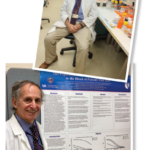ATLANTA—Encouraging data on interleukin (IL) 23/IL-17 pathway drugs in psoriatic arthritis (PsA), JAK inhibitors in rheumatoid arthritis (RA) treatment and new evidence on physical activity and bone health in women were among the highlights of the 2019 ACR/ARP Annual Meeting’s Clinical Year in Review.
Susan Manzi, MD, MPH, director of the Lupus Center for Excellence in the Autoimmunity Institute, Allegheny Health Network, Pittsburgh, who reviewed the clinical headlines, called it “the year for psoriatic arthritis.”
Early, aggressive tumor necrosis factor (TNF) therapy may be beneficial. A study of golimumab plus methotrexate (MTX) vs. MTX alone as first-line treatment of PsA found that not only was there a striking difference in DAS CRP remission over 22 weeks—81% for golimumab and 42% for the MTX-only arm—but the effects were seen early, with a significant difference after just eight weeks, Dr. Manzi noted.1

Dr. Manzi
Other results unveiled over the past year show that the IL-23 inhibitor risankizumab was superior to anti-TNF adalimumab for moderate to severe plaque psoriasis, with 72% vs. 47% respectively achieving at least a 90% reduction in the Psoriasis Area and Severity Index (PASI) over 16 weeks.2 Also encouraging was a large study showing no significant difference in atrial fibrillation and cardiovascular events between ustekinumab and TNF inhibitors.3
Dr. Manzi said data show JAK inhibitors “continue to show promise in RA,” including in patients refractory to biologic disease-modifying anti-rheumatic drugs.
Monotherapy with upadacitinib, a JAK-I inhibitor, in those with active RA and an inadequate response to methotrexate, produced significantly greater ACR20 responses than methotrexate alone over 14 weeks in a recent phase 3 trial.4
Other research has deepened clinicians’ understanding of how to prevent fractures in women. Data from the Women’s Health Initiative—with a population followed over 14 years—show that an increase in physical activity lowers the risk for total fractures and hip fractures among women. A key finding in the study, Dr. Manzi said, is that this protection was seen even in those who were sedentary for more than 9.5 hours a day.5
“Physical activity seemed to mitigate the risk of fractures seen with sedentary behavior,” she said. Mild physical activity, including golf and walking, lowered the fracture risk—an aspect of the study that “may change guidelines,” she said. “This is important since we can encourage light physical activity in our elderly patients who may be frail.”
In other corners of rheumatology, the U.S. Food and Drug Administration (FDA) approved the tyrosine kinase-inhibitor nintedanib for systemic sclerosis interstitial lung disease and the PDE4 inhibitor apremilast for oral ulcers associated with Behçet’s disease.
Other findings raised the prospect of metformin having a potential role in knee osteoarthritis (OA), with an annual medial cartilage loss over four years significantly lower in metformin users than in non-users. This advantage was seen after adjustments for age, gender, body mass index, grade of knee OA, pain score and diabetes.6
David Pisetsky, MD, PhD, professor of medicine and immunology at Duke University School of Medicine, Durham, N.C., said single-cell RNA sequencing and mass spectrometry are providing new troves of gene-expression information down to the level of individual cells in tissue. “Because of the technology, we’ve probably accumulated more data in the last year than the preceding 50,” he said.
The new focus on tissue—rather than peripheral blood—is an important change in rheumatology, Dr. Pisetsky said.

Dr. Pisetsky
“As we begin to think about new approaches to therapy, having information at the site of inflammation is really key,” he said.
The Accelerating Medicines Partnership—a collaboration by the National Institutes of Health, the FDA, companies and nonprofit organizations—is transforming the approach to drug development, with $42.2 million dedicated to rheumatoid arthritis and systemic lupus erythematosus (SLE) for the application of these new technologies.
In one recent study, single-cell transcriptomics and mass cytometry together have helped define the state of inflammatory cells in RA through complex analysis of synovial tissue biopsy samples, Dr. Pisetsky said. The idea is to establish profiles for different cell types—fibroblasts, B cells, monocytes—that could be therapeutic targets.7
In SLE, researchers across several centers analyzed kidney samples using single-cell RNA sequencing, revealing multiple populations of myeloid cells, T cells and other cells that showed both pro-inflammatory and inflammation-resolving responses, chemokine receptors that were expressed widely and other observations.8
Recent research in vasculitis has clarified the role of neutrophil extracellular traps (NETs)—DNA strands that form a mesh-like material that traps bacteria and fungi but can also induce pro-inflammatory activity—in DADA2, a systemic vasculitis, Dr. Pisetsky said. Researchers found that adenosine triggered the formation of NETs. The findings, they say, suggest that modulating this formation could be a new and specific therapeutic angle for DADA2, and maybe other inflammatory diseases.9
‘Single-cell RNA sequencing and mass spectrometry are providing new troves of gene-expression information down to the level of individual cells in tissue.’ —Dr. Pisetsky
Dr. Pisetsky also described advances in the understanding of the processes involved in DNA sensing—in which sensors in the cytoplasm of cells respond to DNA that’s introduced during a viral or bacterial infection, a process that can lead to inflammation; genetic defects in the nucleases that degrade DNA can also increase DNA in the cytoplasm to trigger these receptors. Immune complexes that contain DNA can also enter cells, providing another source of stimulating DNA.
A key sensor, known as cGAS, can lead to the activation of the stimulator of interferon genes (STING) system, then to interferon production.
In lupus, Dr. Pisetsky said, researchers have recently shown that interferon affects this system and prevents the body’s mechanism for cleaning out damaged cells, leading to inflammation.10
“The outcome,” he said, “is too much mitochondrial DNA in terms of the cytoplasm, [which interacts] with the cGAS-STING system and causes upregulation of various cytokines.”
Thomas R. Collins is a freelance writer living in South Florida.
References
- van Mens LJJ, de Jong HM Fluri I, et al. Achieving remission in psoriatic arthritis by early initiation of TNF inhibition: A double-blind, randomised, placebo-controlled trial of golimumab plus methotrexate versus placebo plus methotrexate. Ann Rheum Dis. 2019 May;78(5):610–616.
- Reich K, Gooderham M, Thaci D, et al. Risankizumab compared with adalimumab in patients with moderate-to-severe plaque psoriasis (IMMvent): A randomised, double-blind, active-comparator-controlled phase 3 trial. Lancet. 2019 Aug 17;394(10198):576–586.
- Lee MP, Desai RJ, Jin Y, et al. Association of ustekinumab vs TNF inhibitor therapy with risk of atrial fibrillation and cardiovascular events in patients with psoriasis or psoriatic arthritis. JAMA Dermatol. 2019 Jun 1;155(6):700–707.
- Smolen JS, Pangan AL, Emery P, et al. Upadacitinib as monotherapy in patients with active rheumatoid arthritis and inadequate response to methotrexate (SELECT-MONOTHERAPY): A randomised, placebo-controlled, double-blind phase 3 study. Lancet. 2019 Jun 8;393(10188):2303–2311.
- LaMonte MJ, Watkawski-Wende J, Larson JC, et al. Association of physical activity and fracture risk among postmenopausal women. JAMA Netw Open. 2019;2(10):e1914084
- Wang Y, Hussain SM, Wluka AE, et al. Association between metformin use and disease progression in obese people with knee osteoarthritis: Data from the Osteoarthritis Initiative—a prospective cohort study. Arthritis Res Ther. 2019 May 24;21(1):127.
- Zhang F, Wei K, Slowikowski K, et al. Defining inflammatory cell states in rheumatoid arthritis joint synovial tissues by integrating single-cell transcriptomics and mass cytometry. Nat Immunol. 2019 Jul;20(7):928–942.
- Arazi A, Rao DA, Berthier CC, et al. The immune cell landscape in kidneys of patients with lupus nephritis. Nat Immunol. 2019 Jul;20(7):902–914.
- Carmona-Rivera C, Khaznadar SS, Shwin KW, et al. Deficiency of adenosine deaminase 2 triggers adenosine-mediated NETosis and TNF production in patients with DADA2. Blood. 2019 Jul 25;134(4):395–406.
- Gkirtzimanaki K, Kabrani E, Nikoleri D, et al. IFNα impairs autophagic degradation of mtDNA promoting autoreactivity of SLE monocytes in a STING-dependent fashion. Cell Rep. 2018 Oct 23;25(4):921–933.e5.


